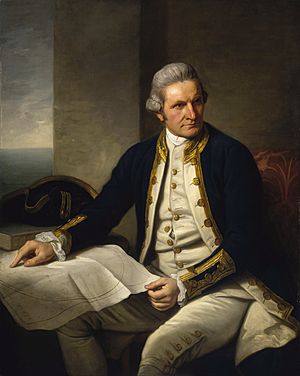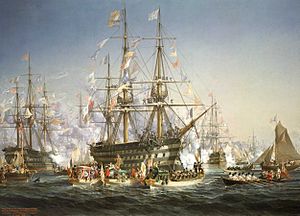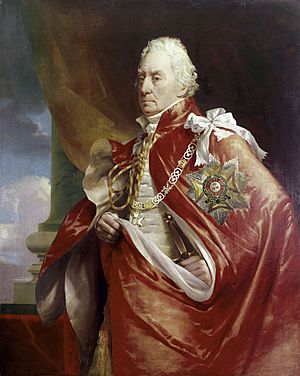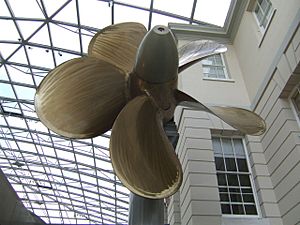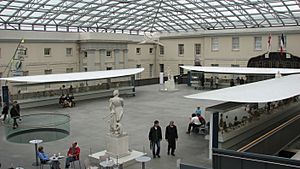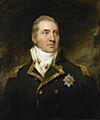National Maritime Museum facts for kids
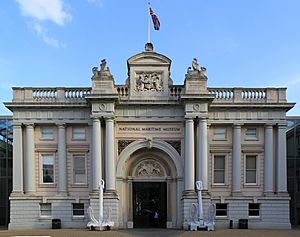
The museum's main entrance
|
|
| Lua error in Module:Location_map at line 420: attempt to index field 'wikibase' (a nil value). | |
| Established | 1937 |
|---|---|
| Location | Greenwich London, SE10 United Kingdom |
| Collection size | 2 million+ objects |
| Visitors | 2,367,904 (2009) |
| Public transit access | |
| Area | 200 acres (0.81 km2) |
The National Maritime Museum (NMM) is a cool place in Greenwich, London, where you can learn all about ships and the sea! It's part of a bigger group called Royal Museums Greenwich. This group of museums is located in a special area of Greenwich that is recognized as a World Heritage Site. Just like many other national museums in the UK, it's usually free to enter. However, some special exhibits might have a small fee.
Contents
How the Museum Started
The National Maritime Museum was officially created by a special law in 1934. It was made possible thanks to many generous gifts, especially from Sir James Caird. King George VI officially opened the museum on April 27, 1937. His daughter, Princess Elizabeth, joined him for the trip along the River Thames from London. Sir Geoffrey Callender was the museum's very first director.
What You Can See at the Museum
Greenwich has always been connected to the sea and finding your way around. The Romans landed here a long time ago. King Henry VIII even lived here! The British Navy also has strong roots in this area. In 1675, King Charles II started the Royal Observatory. Its main job was to help sailors figure out their exact location at sea.
Greenwich has been the home of Greenwich Mean Time and the Prime Meridian since 1884. This means it's been a super important place for studying the stars and time. Sailors all over the world have set their clocks based on Greenwich time.
Amazing Collections
The museum has over two million items! These items tell the story of Britain's history at sea. You can find beautiful maritime art, including paintings from Britain and 17th-century Holland. There are also old maps, important handwritten documents, and models of ships. You can even see real scientific tools that sailors used to navigate and keep time.
Some of the most famous items include paintings of brave sailors like Vice-Admiral Horatio Nelson and Captain James Cook.
The museum often lends its items to other museums. This means people in the UK and other countries can enjoy these amazing historical objects.
Learning About History
The museum wants everyone to better understand British history. It shows how the sea has affected culture, society, and politics. The museum also hosts many special exhibits. Past exhibits have included Ships Clocks & Stars and Samuel Pepys: Plague, Fire, Revolution.
Special Items from History
The museum's collection also includes items from the German Naval Academy Mürwik. These items were brought to the museum after World War II. They are considered "war trophies" and were moved under special agreements made after the war.
The Caird Medal
The museum gives out the Caird Medal every year. This award honors Sir James Caird, who gave so much to help start the museum. It's given to people who have done really important work related to the museum's interests and who share their knowledge with the public.
The Titanic Relics
In 2018, the National Maritime Museum joined with other groups. They wanted to buy 5,500 items from the famous ship, the RMS Titanic. Their goal was to keep all these items together in one collection. They hoped to display them permanently in Belfast, where the Titanic was built, and in Greenwich. However, the groups did not have enough money to buy the collection at the auction.
The Museum's Location in Greenwich
The museum officially opened in 1934. It is located within the beautiful Greenwich Royal Park, which is about 200 acres (0.8 square kilometers). The buildings used to be a school called the Royal Hospital School.
Modern Updates
In 1999, the main galleries of the museum were completely updated. This big project was called Neptune Court. Later, in 2008, a generous person named Sammy Ofer donated £20 million for a brand new gallery.
Between 2016 and 2017, about 2.41 million people visited the National Maritime Museum.
The main galleries had another big update in the early 2020s. This included replacing the roof of Neptune Court. These updates were finished in 2025, and the gallery was renamed the Ocean Court.
Prince Philip Maritime Collections Centre
The museum has another important site nearby in Kidbrooke. It's called the Prince Philip Maritime Collections Centre. This center opened in 2018. It stores about 70,000 items from the museum's collection. You can visit it on special guided tours, but you need to book ahead of time.
Directors of the National Maritime Museum
- 1937–1946: Geoffrey Callender
- 1947–1966: Frank George Griffith Carr
- 1967–1983: Basil Jack Greenhill
- 1983–1986: Neil Cossons
- 1986–2000: Richard Louis Ormond
- 2000–2007: Rear Admiral Roy Clare
- 2007–2019: Dr Kevin Fewster
- 2019–present: Paddy Rogers
Caird Medal Winners
The Caird Medal started in 1984. It celebrates the 50th birthday of the law that created the National Maritime Museum. The medal is given each year to someone who has done amazing work related to the museum's interests. This person must also be good at sharing their knowledge with the public. The medal is named after Sir James Caird, who gave a lot of money to start the museum.
- 1984: Eric McKee
- 1985: Michael S. Robinson
- 1987: Jules van Beylen
- 1989: C. R. Boxer
- 1990: Helen Wallis
- 1991: John F. Coates and John Sinclair Morrison
- 1992: Richard Ollard
- 1993: Gerard L. E. Turner
- 1994: Glyndwr Williams
- 1995: Margaret Rule
- 1996: John de Courcy Ireland
- 1997: Felipe Fernández-Armesto
- 1998: Elly Dekker
- 1999: Elisabeth Mann-Borgese
- 2000: John Hattendorf
- 2002: Robert Ballard
- 2004: Sir David Attenborough
- 2005: Paul Kennedy
- 2006: David Armitage
- 2007: Martin Rees, Baron Rees of Ludlow
- 2010: Willem F. J. Mörzer Bruyns
- 2011: Daniel A. Baugh
- 2014: R. J. B. Knight
- 2015: Simon Schaffer
Images for kids
-
George Rooke by Michael Dahl, c. 1705
-
Edward Russell by Godfrey Kneller, c. 1710
-
Portrait of Augustus Keppel by Joshua Reynolds, 1749
-
Edward Hawke by Francis Cotes, c. 1768
-
Portrait of the Earl of Sandwich by Thomas Gainsborough, 1783
-
Portrait of Sir Edward Pellew by Thomas Lawrence, 1797
-
Napoleon on the Bellerophon by Charles Lock Eastlake, 1815
-
Portrait of George Cockburn by William Beechey, 1820
-
Wager's Action off Cartagena by Samuel Scott, c.1747
-
The Glorious First of June by Philip James de Loutherbourg, 1795
-
Nelson and the Bear by Richard Westall, 1809
-
The Battle of Trafalgar by J. M. W. Turner, 1822–24
-
Dead Calm by Augustus Wall Callcott, 1827
See also
 In Spanish: Museo Marítimo Nacional (Reino Unido) para niños
In Spanish: Museo Marítimo Nacional (Reino Unido) para niños
- Britain and the Sea
- British Maritime Charitable Foundation
- Greenwich Visitor Centre
- List of London museums
- National Historic Fleet
- National Museum of the Royal Navy
- National Waterways Museum—the UK's national museum of inland waterway transport
- Het Scheepvaartmuseum (Netherlands Maritime Museum)


